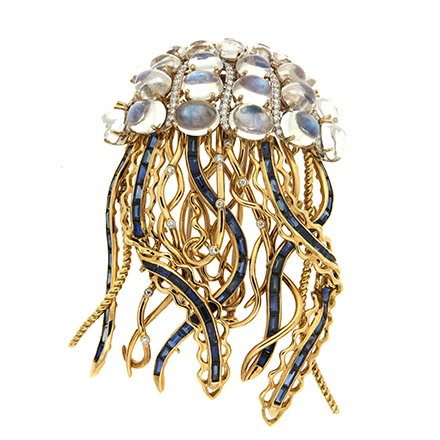How They Work
Most brooches today consist of several parts. There’s the front portion, which serves as the decorative area. The back holds the functional elements of the brooch. These may consist of a clip or pinstem. If the latter, the pin is usually connected to a hinge for ease of fastening. This may be secured with a clasp to prevent unwanted shifting.
Dress clips, also known as clip brooches, come in multiple forms. One version has a double pronged pin attached to a hinge. Another type is the double brooch, which consists of mirror image pieces which can be worn as one or separated as the wearer desires. A third kind of uses a wide, blunt piece of metal that uses pressure to hold the jewelry in place. This last version is a good match for delicate clothing.
Pin brooches depend on pinstem needles and clasps for security. The pinstem pierces fabric in multiple spots to stay in place. Some material can withstand this treatment, while others may need rubbing to remove the holes left behind. Those unsure if their favorite clothes are compatible with brooches may want to do a spot test on an inner seam.
The earliest known brooches come from the Bronze Age. The Romans called theirs “fibulae” and used them to fasten clothing. Most were made of iron or bronze, though jeweled versions of silver and gold exist as well. They came in a host of designs, including arches, spirals and even animals.
Penannular and pseudo-penannular brooches, also known as Celtic brooches, premiered during the Iron Age. The body of these pieces are incomplete circles which serve as both decoration and clasp. Their pins are much longer than the main piece. After piercing the fabric, the pinstem is maneuvered through the gap in the circle and rests against the body. Pressure holds the arrangement in place.
Many of these early brooches are on display in museums. A few are distinct enough to have their own names. Several pieces, including the Tara, Breadalbane and Hunterston brooches are made in both silver and gold. They’re decorated horror vacui style, with every available space covered in embellishments.
Multitasking Brooches
Brooches were first developed to fasten clothing. Even though they transformed into ornamental pieces, their designs remain ideal for serving multiple roles. Some are still used to hold clothing in place, others help with organization and yet more keep precious items close at hand.
Scarf pins are a pared down type of brooch. There is no hinge or clasp, and decorative portion is smaller and attached to the end of a long stickpin. True to their name, scarf pins are designed to hold scarves, neckties and other loose items in place.
Watch brooches are a blend of pocket watches and brooches. Instead of being tucked away, the watch is suspended from a pin and worn in full view. These pieces may be decorated like any other watch or brooch, have an exposed face or a cover to conceal the clock.
Brooches can also be combined with lockets. Suspended from the pin is a container designed to hold keepsakes such as photographs. These may be decorated with gemstones, engravings, or other embellishment items. In a show of sentimentality, locket brooches can be pinned over the heart.
Motifs
In jewelry, a motif is a singular or recurring design or color. The versatility of brooch size and shape make it an excellent medium to try different looks. Brooches can be flat, three dimensional, realistic, stylized and less tied to fitting the body compared to pieces like earrings. Some popular aesthetics for brooches are described below.
Floral brooches have many forms. One style is a single large flower with petals fashioned from carved gemstones, and a center made of smaller jewels. The bloom may be left as is, or edged with jeweled leaves, ribbons or gold branches. A series of smaller carved flowers can adorn an enamel vase or wheelbarrow, or rest upon a precious metal trellis. Stylized gem flowers may be used to highlight knots of polished gold and diamonds.
Nautical motifs provide a wealth of whimsical looks. Jellyfish and snails can provide hanging elements which move with the wearer. A diamond starfish may gain spots of color not just from sapphires, but tiny gold starfish resting on its legs. The bumpy texture of seahorses gives designers a change to play with shaping gold as well as the chance to experiment with gemstone combinations.
Other animals also look attractive on brooches. Frogs may be made of gold with gemstone eyes, or have a skin of green jewels. A diamond snake might wrap around a large gem to keep it safe. Butterfly wings may be made of carved jewels mounted with yet more gems. A dog could sport a diamond collar as it watches over its wearer.
A subtler motif is texture. Gold and platinum can be polished to a high sheen, twisted into rope, brushed, grooved and so on. Layering these textures adds depth to the design. Sometimes these elements are entwined around each other like with knots, applied one on top the other, or incorporated into a larger motif. Either way, they help create a brooch one is happy to wear.






